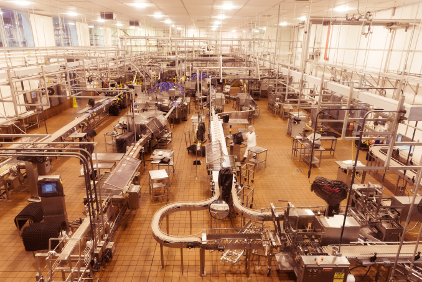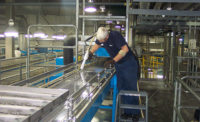Automating safety through clean-in-place systems
Clean-in-place and open-plant cleaning systems are utilizing automation and improved chemicals to improve sanitation and sustainability.

 Historically, clean-in-place and open-plant cleaning systems haven’t changed much in decades, perhaps even 40 to 50 years. However, change is coming as these systems embrace sustainability measures and add more automation.
Historically, clean-in-place and open-plant cleaning systems haven’t changed much in decades, perhaps even 40 to 50 years. However, change is coming as these systems embrace sustainability measures and add more automation.
Clean-in-place (CIP) is usually utilized in closed process systems with tanks or other vessels and pipelines to clean fluid product lines, such as dairy products and beverages or liquid foods such as sauces and dressings.
Open-plant cleaning is typically a manual process, though many aspects can be automated with custom-engineered cleaning systems.
“CIP does a good job cleaning pipes and closed systems, but if the chemicals aren’t strong enough then a buildup of biofilm can form which employees wouldn’t see,” notes Scott Russell, Ph.D., professor of poultry processing and products microbiology, University of Georgia, Athens, Ga.
According to sources, increased automation in cleaning processes helps processors realize improved and consistent cleaning and sanitizing results, which consequently leads to improved food safety, less opportunity for operator error and precise dosing of sanitation chemicals to improve cost efficiencies and help reduce effluent impacts.
Another benefit of automation is, of course, less cleaning time and labor for staff.
Automation can also lead to water and energy savings through automated controls that are programmed to optimize water and energy usage and water reconditioning and water reuse technologies that can help to reduce water usage.
After all, every gallon of water that is saved is another gallon that doesn’t have to be heated, treated with chemicals and disposed of by plants.
Improved reporting and documentation also provide product usage reports that are available on demand.
Improving food safety
Every time a microbial contamination or product recall occurs, all processors review their standard food-safety procedures and cleaning systems.
“Anyone producing high risk product like refrigerated, ready-to-eat items should be aware, make changes and incorporate the latest technologies into their operations,” says Kevin Keener, Ph.D., professor of food science, Purdue University, West Lafayette, Ind. “At the same time, there isn’t a magic bullet; we have to recognize that bacteria will make its way into the process.”
Last year, Cargill twice recalled its ground turkey products due to a Salmonella Heidelberg outbreak. As a result of the ground turkey recalls and a subsequent review of its food-safety measures, Cargill has adopted an even more stringent sampling and monitoring program, but still faced a ground beef recall this summer from a Salmonella outbreak.
“As a vertically integrated turkey processor, we enhanced our turkey food-safety interventions across the supply chain from feed mills to the grind area, which has helped us become better and stronger in our approach to food safety,” says Michael Martin, director of communications, Cargill. “We continue to search for better ways to address naturally and randomly occurring bacteria such as E. coli and Salmonella, which have thousands of strains and are found throughout the natural environment.”
Recently, allergen control has also become top of mind during further processing because of its impact on young children.
Automated cleaning systems can certainly validate plant cleaning efforts and monitor the right chemical concentrations and flow rates.
Indeed, experts say that an effective food-safety program requires a total plant approach, including a comprehensive cleaning and sanitizing program, continuous conveyor belt-treatment program to help reduce counts during the production day, plant environment care, personnel hygiene and comprehensive pest elimination.
In USDA-approved plants, processors still need to be able to dissemble their pipes and vessels for visual inspections, notes Lee Johnson, Ph.D., vice president of technical services, West Liberty Foods, West Liberty, Iowa.
“We use CIP with our liquid-based ingredients like brines, in our chillers and filtration,” he says. “The ability to be able to take apart and clean CIP systems increases food safety tremendously.”
Preventing wear and tear
All of that disassembly takes its toll on equipment parts though, notes Johnson.
“The biggest challenge with CIP is definitely that dissembling the pipes — in a somewhat fast timeframe — takes its toll,” he says. “The key is making sure you’re careful and having an ‘everything has a home’ mindset when putting the pipes down so they can be reassembled correctly.”
The whole idea behind CIP is that processors wouldn’t have to break down their machines every night for cleaning, notes Russell, but the worry then is that processors won’t know if their chemical solutions aren’t removing biofilms, which will happily grow unnoticed and later become resistant to chemicals.
Also, in meat and poultry processing, there are always junctions and corners joined by gaskets in machines to consider that are vulnerable to biofilm development.
“Peracetic acids are becoming a popular, effective and ‘new’ — from the last 10 years — chemical for breaking down biofilms, and are catching on,” he notes. This solution is an alternative to another method: processors increasing their chlorine levels until they work more effectively.
Certainly, it is important that equipment manufacturers design new systems with “cleanability” in mind. It may sound simple, but ultimately processors need to understand how their new equipment works and needs to be cleaned.
“There is a certain underlying assumption in the industry sometimes that once they buy the equipment, it will work as it should,” says Keener. “And the complexity of the system and the importance of cleaning it is overlooked.”
Looking for a reprint of this article?
From high-res PDFs to custom plaques, order your copy today!









